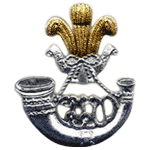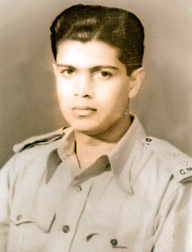
Lieutenant General Denzil Lakshman Kobbekaduwa, RWP, RSP, VSV, USP, rcds, psc, SLAC was a Sri Lankan General. He led some of the most successful military operations in the early part of the Sri Lankan Civil War, such as Vadamarachchi Operation and Operation Balavegaya. He was mortally wounded and his commanders and staff killed when the Land Rover they were travelling in hit a land mine in the island of Kayts while making preparations for Operation Final Countdown the proposed invasion of the Jaffna Peninsula.

The Janatha Vimukthi Peramuna, often abbreviated as JVP is a communist and Marxist–Leninist party and political movement in Sri Lanka. The movement was involved in two armed uprisings against the ruling governments in 1971 (SLFP) and 1987–89 (UNP).
The 1971 Janatha Vimukthi Peramuna insurrection was the first unsuccessful armed revolt conducted by the communist Janatha Vimukthi Peramuna (JVP) against the Government of Ceylon under Prime Minister Sirimavo Bandaranaike. The revolt began on 5 April 1971 and lasted till June 1971. The insurgents were able to capture and hold several towns and rural areas for several weeks until they were recaptured by the armed forces. Even though its first attempt to seize power in 1971 was quickly crushed by force, in 1987 this group launched another far more potent insurgency in the south, central and western regions of the country.

The Sri Lankan Army (SLA) is the oldest and largest of the Sri Lanka Armed Forces. Established as the Ceylon Army in 1949, it was renamed when Sri Lanka became a republic in 1972. In 2010, the Army had approximately 200,000 regular personnel, between 20,000–40,000 reserve personnel and 18,000 National Guardsmen and comprises 13 operational divisions, one air-mobile brigade, one commando brigade, one special forces brigade, one independent armored brigade, three mechanized infantry brigades and over 40 infantry brigades. From the 1980s to 2009 the army was engaged in the Sri Lankan Civil War.

The Sri Lanka Armoured Corps (SLAC) provides the armour capability of the Sri Lanka Army, with vehicles such as the VT1A, T-55AM2, and ZTZ88 main battle tanks, the BMP infantry fighting vehicle and the BTR-80, and WZ551 armoured personnel carriers. It comprises six regular armoured regiments and a volunteer (reserve) regiment. It has an independent Armoured Brigade and is headquartered at Rock House Army Camp, Colombo.

The Sri Lanka Light Infantry (SLLI) is the oldest regiment in the Sri Lanka Army and the oldest infantry regiment in the army. It is made up of ten regular battalions and five volunteer battalions, and is headquartered at the Panagoda Cantonment, Panagoda. Over the years it has become the most distinguished and dependable regiment in the army.

Lieutenant Colonel Nandasena Gotabaya Rajapaksa, RWP, RSP, psc, GR is a Sri Lankan politician, technocrat, and military officer, who is the current President of Sri Lanka. He served as Secretary to the Ministry of Defence and Urban Development from 2005 to 2015 under the administration of his elder brother former President Mahinda Rajapaksa, leading the Sri Lankan Armed Forces to the military defeat of the Tamil tigers, ending the Sri Lankan Civil War.
The Sri Lanka Army Medical Corps (SLMC) is a specialist corps in the Sri Lanka Army which provides medical services to all army personnel and their families in war and in peace. It is made up of 4 regular units and one volunteer unit. Headquartered in Colombo, formally at army headquarters. The corps Cap badge depicting the Rod of Asclepius.

Major General Janaka Perera, RWP, RSP, VSV, USP, VSP, rcds, psc, CR was a Sri Lankan General and politician. He served as the Chief of Staff of the Sri Lanka Army and is considered one of the most distinguished generals in Sri Lankan history. After retiring from the army he served as a Sri Lankan High Commissioner to Australia and Ambassador to Indonesia. He was the opposition leader of the North Central Provincial Council until he and his wife were killed on 6 October 2008 by a suicide bomber. The LTTE have been blamed for the bombing by Sri Lankan president Mahinda Rajapaksa.
General Tissa Indraka Weeratunga, VSV, ndc, psc, GW was a Sri Lanka general. He was a former Commander of the Sri Lankan Army and first General Officer Commanding (GOC) of the Joint Operations Headquarters (JOH), he was later Sri Lanka's High Commissioner to Canada.

Lieutenant Colonel Dr. Anthony St. Clare Rex de Costa, MBE, CAVF was a renowned Sri Lankan medical doctor and soldier. He was the commanding officer of the Ruhunu Regiment, a doctor in the Ceylon Defence Force during World War II and a vice president of the World Veterans Federation. He was assassinated by the JVP during the 1971 Insurrection.
General S. Cyril Ranatunga, VSV, rcds, psc was a Sri Lankan general. He was the former General Officer Commanding, Joint Operations Command and Chief of Staff of the Sri Lanka Army during the 1980s. He also served as the Permanent Secretary to the Ministry of Defence as well as Sri Lankan High Commissioner to Australia and the United Kingdom.
General Hamilton Wanasinghe, VSV is a Sri Lankan general. He was the 11th Commander of the Sri Lankan Army (1988-1991), third General Officer Commanding (GOC) of the Joint Operations Headquarters (JOH) (1991-1993) and Permanent Secretary for Defense. was the 11th Commander of the Sri Lankan Army (1993-1995). He was appointed on 16 August 1988 until 15 November 1991. He was succeeded by Cecil Waidyaratne.
General L. D. E. Cecil Waidyaratne, VSV, USP, ndc, psc, SLAC was a Sri Lankan general. He was 12th Commander of the Sri Lankan Army and a former Sri Lankan Ambassador to Thailand.
General Gerard Hector "Gerry" De Silva, RWP, VSV, USP is a Sri Lankan general. He was the 13th Commander of the Sri Lankan Army and Sri Lankan High Commissioner to Pakistan.
Lieutenant General Henry Vijaya Athukorale, VSV, psc, FBIM was a Sri Lankan general. He served as Commandant, Volunteer Force and Commander, Task Force Anti Illicit Immigration.
Major General Hikkaduwage Gratian Silva, VSV, FBIM was a Sri Lankan military leader, he served as the Military Secretary.
Major General Duleep Justin De Sliva Wickramanayake was a Sri Lankan military leader, he served as the Director Operations and Training of the Sri Lanka Army.
Brigadier S. B. Miyanadeniya was a Sri Lankan military leader, he served as the Director Training, Sri Lanka Army.







